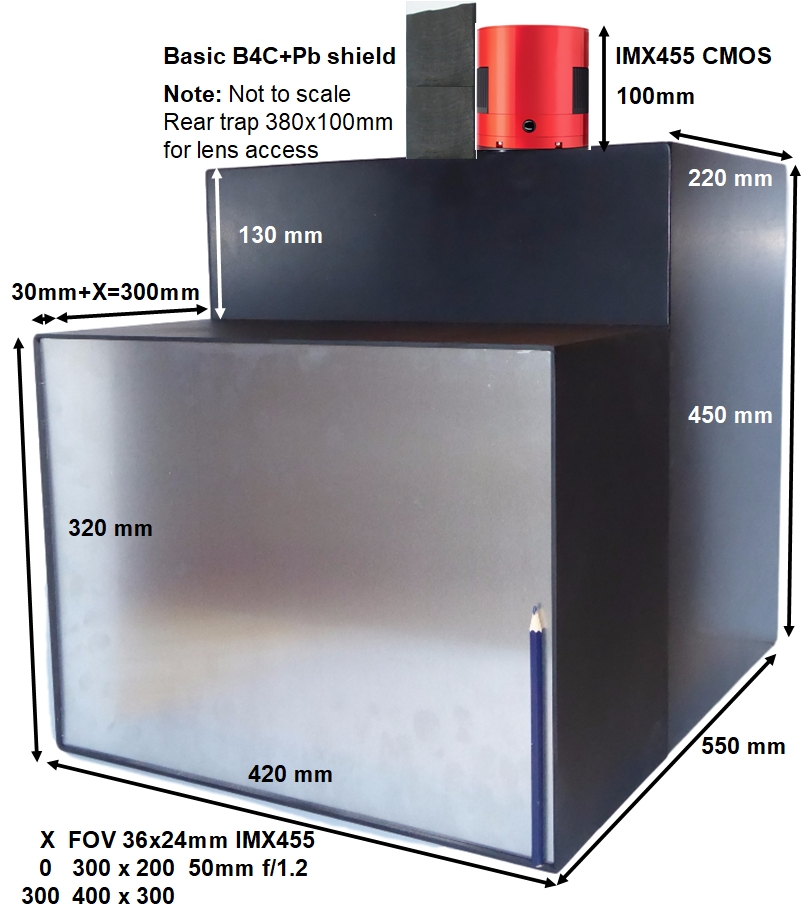Then you can perform first measurements to support funding for further developement.
How can an inexpensive NeutronOptics Camera compete, and what more do you need ?
Try our ImageJ Barrel Distortion Correction macro and example image stack.
Choice of Detector for Different Applications
Our cameras have two main uses; tomographic imaging and in-beam sample alignment. Cameras for radiography use large cooled detectors with big lenses, while alignment cameras are simpler. We use the same scintillators, mirrors and lenses as for the most expensive cameras, but reduce costs with fixed geometry, laser-cut welded or simple cast aluminium boxes and a large variety of commercial Sony CMOS detectors.We use readily available components that can easily be replaced, even by the end-user.
Upgrading your old CCD camera can give you big gains in both speed and resolution!
Very High Resolution Neutron and X-ray Cameras
Very high resolution (<25 µm) requires thin scintillators, which are not very bright, so the camera itself must be very efficient. For small fields-of-View (FOV) of 20-30 mm this is best achieved with our 1:1 Tandem Macro camera, but otherwise we must maximise the ratio of the area of the sensor to the area of the FOV, using bright close-focus lenses; the aperture of a normal macro lens is typically f/2.8, which is only 25% as bright as f/1.0. Our cooled 24x16mm Sony IMX571 sensor with an f/0.95 APS-C lens is ideal for a high resolution camera with an optical resolution of <25 µm over 125x100 mm.
A B4C/Pb bolt-on detector shield is recommended.
We can provide it with either 100 µm RC-TriTec 6LiF/ZnS scintillators, or even higher resolution RC-TriTec 20 µm Gd2O2S2:Tb scintillators. The GadOx scintillators are only ~8% as bright as the 100 µm 6LiF/ZnS scintillators, but can achieve a resolution of 25 µm.
400x300mm Cooled CMOS X-ray or Neutron Camera
This 400x300mm camera, constructed for the new Venus BL at SNS ORNL, uses a full-frame 36x24mm IMX455 CMOS detector with 9576x6388 16-bit pixels giving 50 micron optical resolution with a bright Nikon 50mm f/1.2 lens. It has high efficiency and low noise.By removing the horizontal extension, the FOV can be reduced to ~300x200mm, increasing both intensity and optical resolution. We recommend small FOVs for lower flux sources, but a larger 500x400mm camera is being constructed for the University of California.
The 400x300mm neutron camera costs <€20K, ready to operate including the scintillators.
Extra lead shielding is recommended below and around the detector. See the user manual.
3D Tomographic Reconstruction
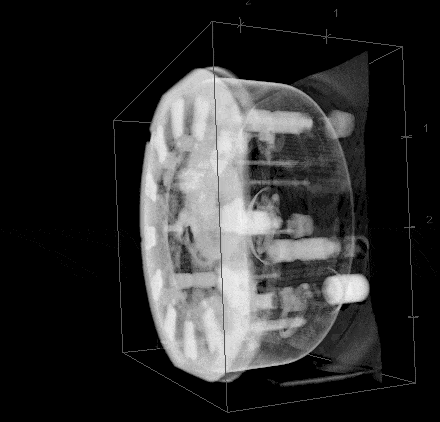 Tomographic Reconstruction requires efficient cameras because many radioagraphs must be collected by rotating the sample at small angular intervals. We recommend the Newport Micro-Controle URS turntables for sample alignment and rotation, and provide simple scripts to synchronise turntable rotation stepping with radiographic imaging. We are grateful to Anders Kaestner at PSI Switzerland for making his tomographic reconstruction programs freely available, and to Burkhard Schillinger at FRM-2 Munich for providing an excellent neutron tomographic data set for a clock.
Tomographic Reconstruction requires efficient cameras because many radioagraphs must be collected by rotating the sample at small angular intervals. We recommend the Newport Micro-Controle URS turntables for sample alignment and rotation, and provide simple scripts to synchronise turntable rotation stepping with radiographic imaging. We are grateful to Anders Kaestner at PSI Switzerland for making his tomographic reconstruction programs freely available, and to Burkhard Schillinger at FRM-2 Munich for providing an excellent neutron tomographic data set for a clock.
Fast Neutron Radiography with our Cameras
Fast neutrons (2.45MeV or 14MeV) are very much harder to detect than thermal neutrons because they are not captured by nuclei to provide ionising fission fragments. Scintillation in ZnS can however be achieved with knock-on protons rather than 6Li fission, though long exposures are needed. Fast neutron scintillators use high density polypropylene PP as a source of knock-on protons, and NeutronOptics now offer RC-TriTec PP-ZnS scintillators. Standard sizes are 75x50mm, 125x100mm and 250x200mm (smaller is more efficient).Extra lead shielding is recommended around the detector.

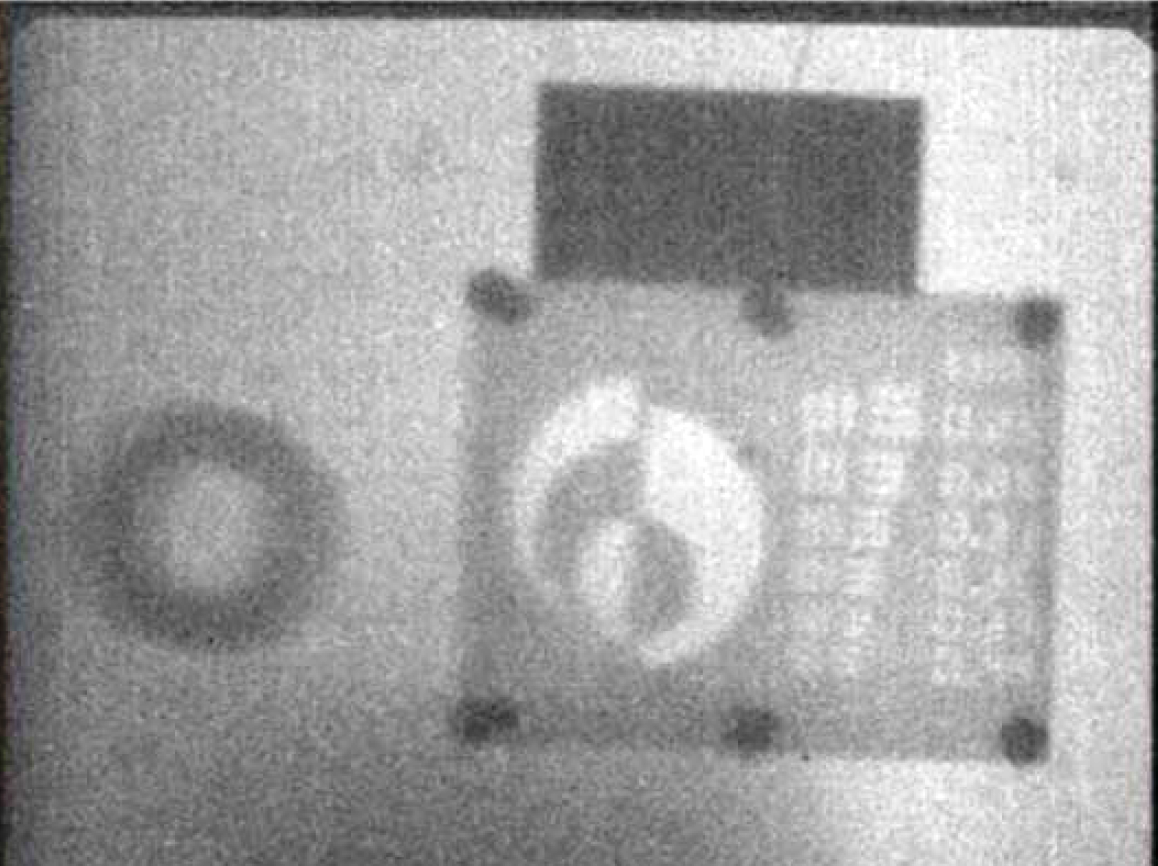
Small D-D and D-T neutron generators are a promising development for low-cost neutron radiography, though the fast neutron flux is low. Even so, one of our 250x200mm cameras has already been used with an AdelphiTech 2.45 MeV D-D neutron generator to obtain radiographs with ~10min exposures (above).
An Experts Meeting on Fast Neutron Radiography at FRM2 Munich in October 2019 summarises progress, and includes our paper on An Efficient Camera for Fast Neutrons.
![]()
125x100mm Cooled APS-C CMOS Laue Camera
Over 25 years we have developed various Laue crystal alignment cameras for neutrons and x-rays. A finely collimated white beam produces a number of "Bragg spots" from a single crystal, and by measuring the positions of these spots the crystal orientation can be determined. Greater precision is obtained with backscattering, but the intensities are weaker, especially for x-rays because of the scattering "form-factor". A classic bench-top x-ray generator with a spot size of ~1mm and power of 30-50 kV and 30-50 mA is required. The photo shows our new 125x100mm CMOS camera, which is the same size, but x6 more efficient than our old 1-CCD Laue camera for the same price.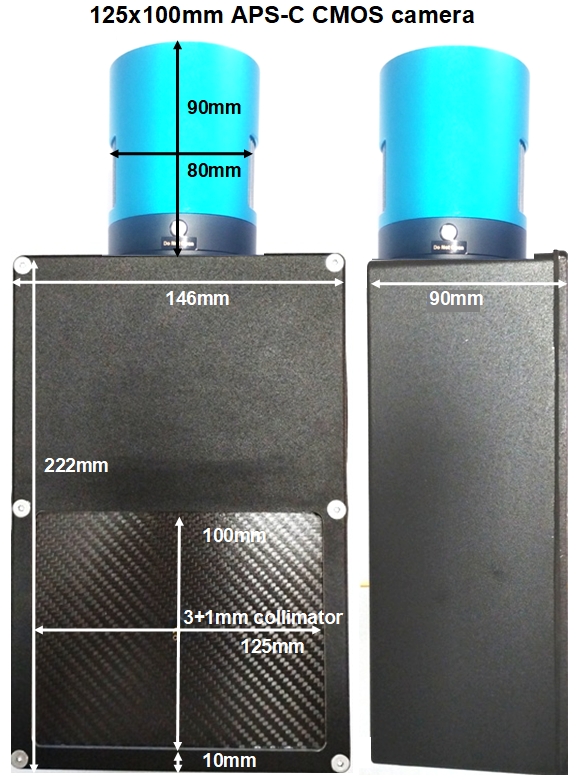

The Si backscattered Laue pattern (above left) was obtained in 2min by Dr Dean Hudek at Brown University with our less efficient 1-CCD camera, and a W pattern (below) was obtained in only 30s on a 2kW generator with W cathode operated at ~35keV with our more efficient 1-CMOS camera (click to enlarge). This German industrial customer converted from an Image Plate Laue diffractometer. For details, see the CMOS Laue camera manual

180x120mm Cooled APS-C CMOS Laue Camera
This large 1-CMOS Laue camera is designed to replace our old 2-CCD Laue camera. By using a larger APS-C 24x16mm CMOS detector instead of two 12.5x10mm CCDs, we increase the total detector area (efficiency) by over 50% allowing a slightly larger Field-Of-View (FOV) for similar exposure times (3-5 minutes). The efficiency is further improved by using a modern f/0.95 lens instead of a pair of f/1.4 lenses. The incident beam collimator (1mm/2mm) passes through a mirror and a scintillator in the centre of the camera, and the backscattered diffraction pattern is collected in real time for precise crystal orientation. This new camera with higher efficiency and simpler operation is also less expensive !The dimensions can be adjusted to order.
See the CMOS Laue camera manual
Small CMOS neutron or x-ray alignment cameras
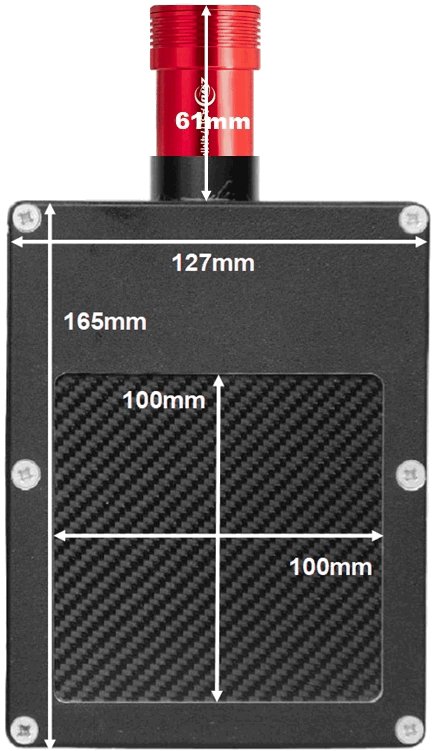
USB powered CMOS detectors can be used instead of our slim CCD, increasing resolution and frame rate.
C-windows (x-rays) or Al-windows (neutrons) are used.
Smaller 75x50mm compact cameras or 100x50mm
slim cameras may be more suitable for cramped sample environments.
A larger
125x125mm version or even a
simple 200x125mm guide tube monitoring camera are also available, with optional higher resolution detectors. Note that the detector can be off-centered to reduce camera depth.
The mini-iCam neutron or x-ray camera
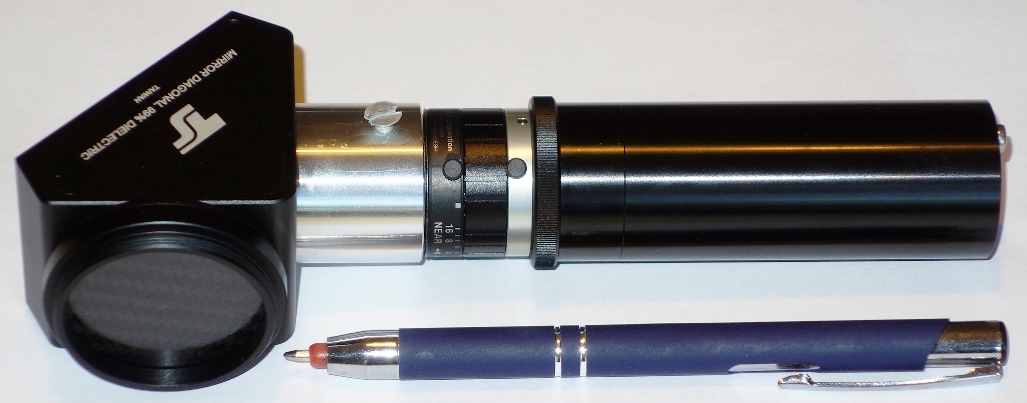
The mini i-Cam is our smallest (and cheapest) x-ray or neutron camera, using the slim CCD. It is intended for the alignment of small beams and samples, with USB power and easily interchangeable x-ray and neutron scintillators. A CMOS version is capable of at least 25µ resolution and high frame-rates.
![]()
High Resolution Macro Neutron and X-ray Cameras
We offer two types of macro camera; the normal macro camera which uses a close-up 1:1 macro lens, and the tandem-macro camera, which uses a pair of normal lenses front-to-front, both focussed at infinity. Tandem macro cameras are claimed by PCO to be competitive in efficiency to fibre-optic bundles bonded directly to the chip, combining high efficiency with high resolution, but the FOV is small (~10mm diameter). The FOV of our normal 1:1 macro camera is equal to the size of the detector chip, up to 36x24mm for the full-frame IMX455. The FOV can be doubled to 2:1 or more by using object extension tubes.
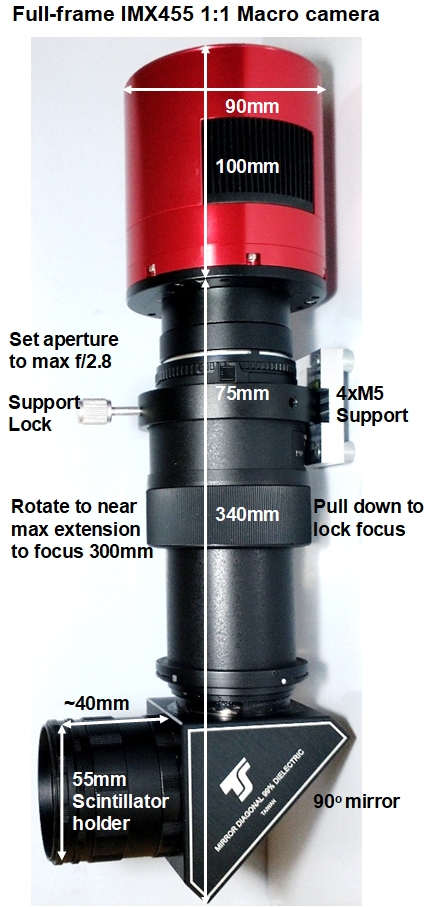 The full-frame IMX455 1:1 Macro camera (left) offers optical resolution equal to the 3.76 µm pixel size of the CMOS chip, with a FOV of 36x24 mm. The FOV can be doubled using the scintillator extension, halving the resolution. The resolution and brightness is less than our Tandem Macro camera, with its FOV of only ~10 mm.
The full-frame IMX455 1:1 Macro camera (left) offers optical resolution equal to the 3.76 µm pixel size of the CMOS chip, with a FOV of 36x24 mm. The FOV can be doubled using the scintillator extension, halving the resolution. The resolution and brightness is less than our Tandem Macro camera, with its FOV of only ~10 mm.
A 50µ grid can be imaged with 3.8µ pixels to a resolution of <10µ, depending on the scintillator and collimation. The real resolution depends on the scintillator, and we recommend Ultrafine GadOx scintillators, or columnar CsI scintillators as an alternative to our standard CAWO OG2 scintillator.
The camera is shown with a carbon fibre x-ray window, which unscrews to change the scintillator; thin aluminium windows are used for neutrons. Focus locking is obtained by simply pulling the focus ring, with an option for remote focussing, using a manual control box or a USB connection.
For cameras less than full-frame, we can use less expensive APS-C detectors, such as the 24x16mm IMX571 detector with a compact APS-C macro lens.
For details, see the CMOS Macro Camera manual.
Efficient Tandem Macro Neutron & X-ray Cameras
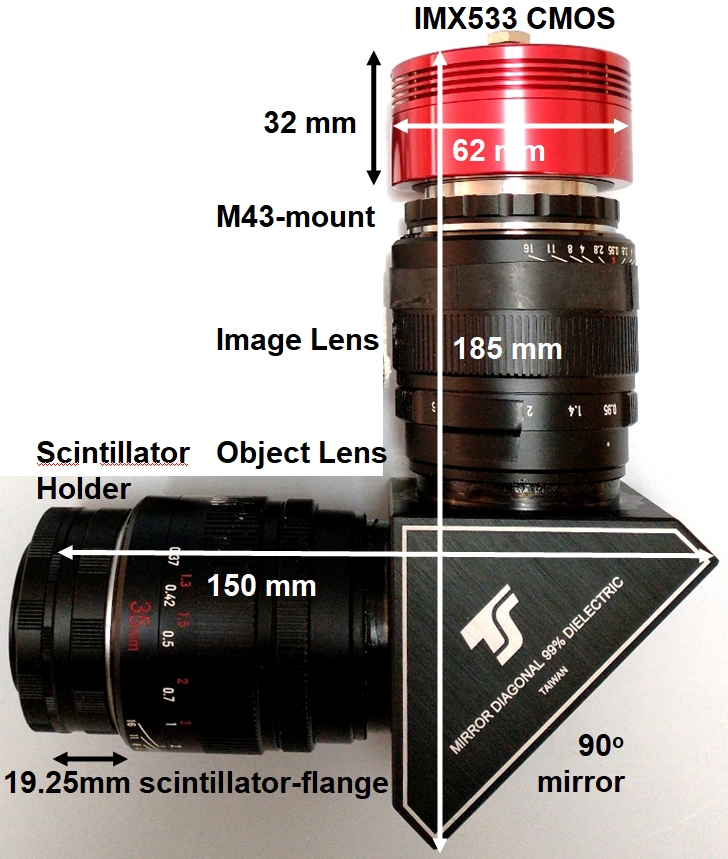 In this Tandem Macro camera, a pair of 35mm f/0.95 tandem lenses is x8 brighter than our normal macro camera, with similar 1:1 resolution. Maximising intensity is important when thin scintillators are used for the highest resolution.
In this Tandem Macro camera, a pair of 35mm f/0.95 tandem lenses is x8 brighter than our normal macro camera, with similar 1:1 resolution. Maximising intensity is important when thin scintillators are used for the highest resolution.
Since the FOV is necessarily small, we have chosen a smaller 11.3x11.3mm IMX533 detector, coupled with a pair of f/0.95 micro-4/3" lenses. Different focal lengths can be used, depending on the required magnification and intensity. For example, our normal macro camera could use a Tandem Macro option, with a 35mm f/1.2 imaging lens in front of the 100mm lens, to give a 3:1 macro image of our 50µ wire grid.
See our Tandem Macro Camera Manual.
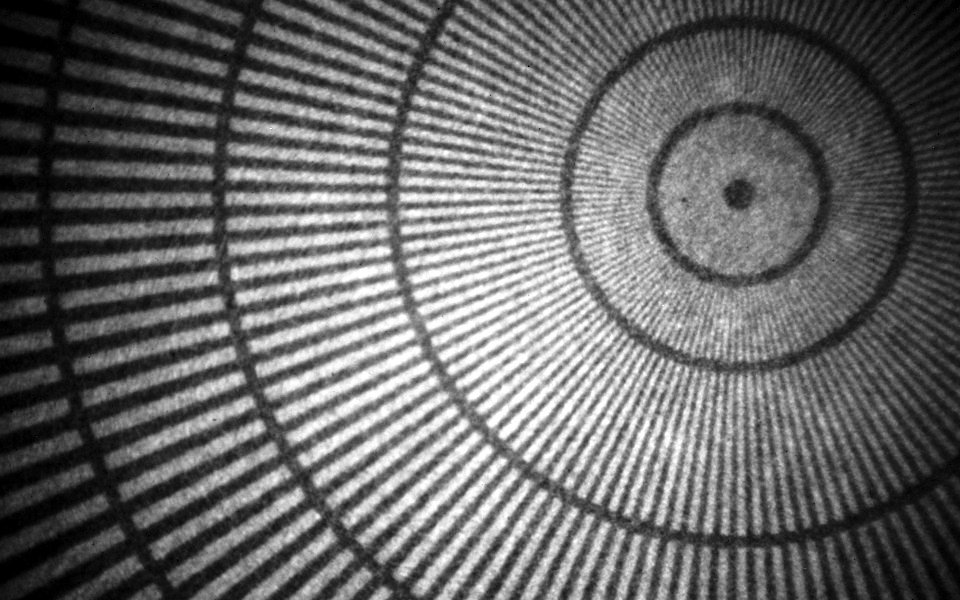
The image on the right was obtained on the ILL NeXT D50 beamline from our Twin Nikkor 50mm 1:1 camera using a 10µ thick Gd2O2S:Tb/6LiF PSI/RC-TriTec scintillator with 6% of the light output of their 200µ scintillator. The inner circle shows that at least 25µ resolution was obtained for an exposure of only 3s with a neutron flux estimated to be ~5x10**7 n/cm2/s.
Gd2O2S is also a good x-ray scintillator. (Credits: Alessandro Tengattini & Lukas Helfen, ILL)
![]()
Want to use your own detector or a custom camera ?
If you already have a detector we can probably build a camera box for it to your own specifications, with or without scintillators and lenses. Our custom laser cut and welded aluminium boxes with B4C light-tight baffles and aluminium screws can be provided with a choice of front-end path lengths to suit the size of your detector and the focal length of your lens. You simply bolt your detector to the end of the main box, and swap front-ends and/or lenses to change your Field-of-View and resolution.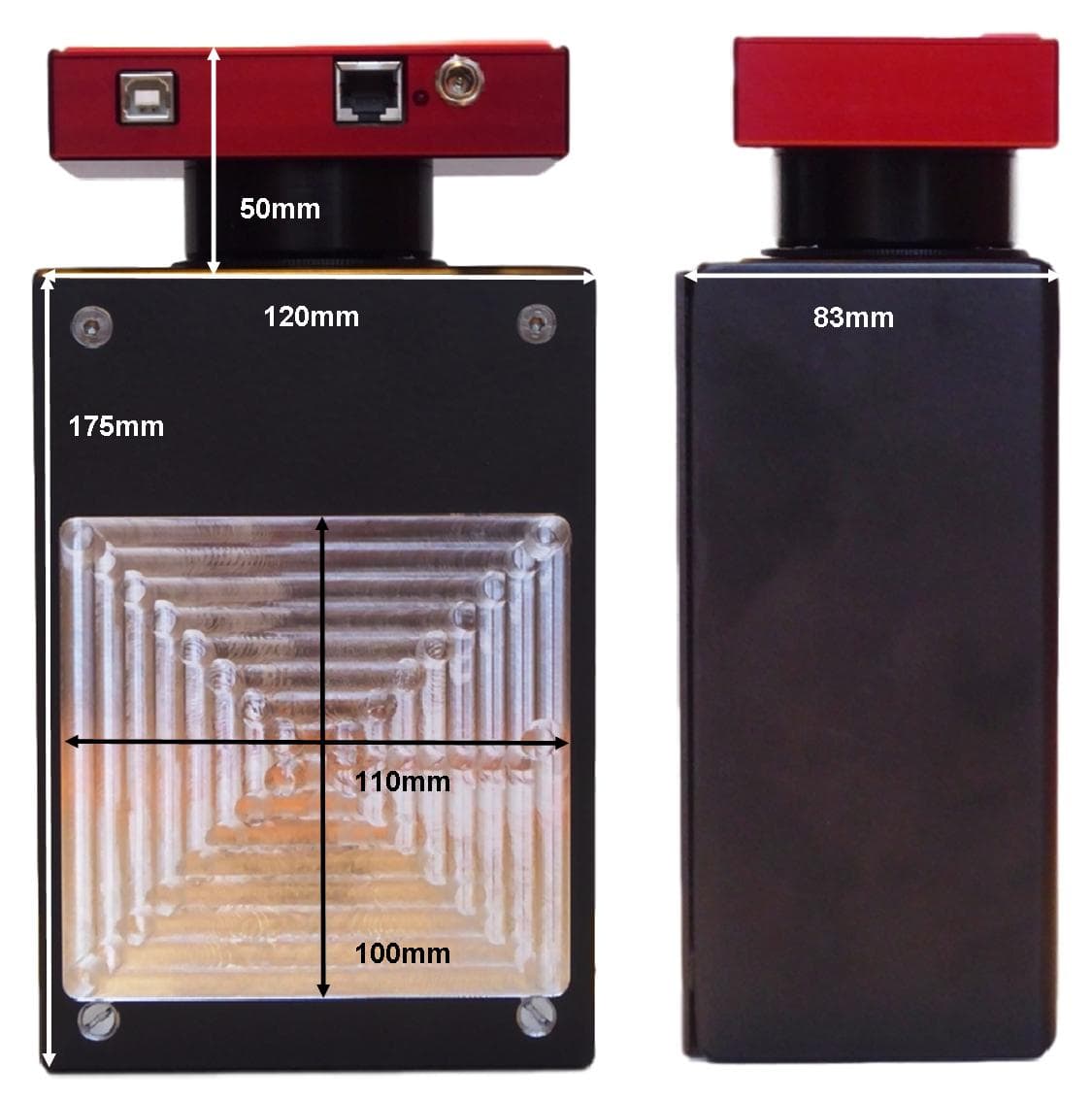
For example, a 110x100mm Field-of-View was required with the smallest possible high-resolution camera embedded in shielding behind a pressure cell on the ISIS pulsed source.
We designed a camera using an uncooled 1392x1040 pixel Sony ICX825ALA CCD in a compact housing. Full-frame readout is only 0.5s and multiple exposures can be stacked in real-time to build up an image of the sample in a strongly absorbing environment.
Tell us your specific requirement and we will build a camera to satisfy it.
(Click on the photos to enlarge them).
CYCLOPS - 16-CCD 360-degree Neutron Laue Camera
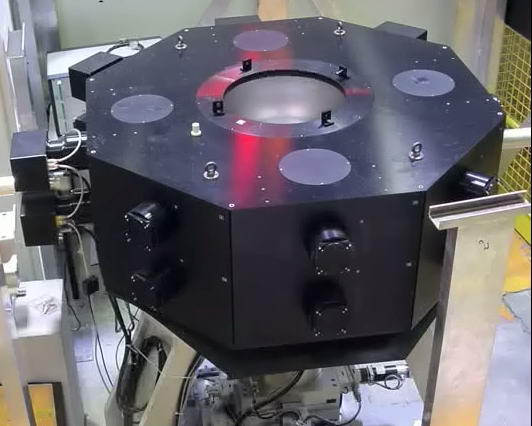

CYCLOPS is a very fast neutron Laue camera constructed for ILL Grenoble according to an ILL "Millenium Program" proposal. It consists of 16 image-intensified Peltier-cooled CCDs scanning an octagonal scintillator to cover almost complete 4π scattering in real time. Total readout time is only ~1 sec for the complete 7680x2400 array of 170µ pixels as an 8, 12 or 16-bit TIF image. A complete diffraction pattern can be obtained in only a few seconds, making it possible to follow changes in crystal structure as a function of temperature, pressure or magnetic field. Here is a short streaming video illustrating the astonishing power of such a machine, even if at present it is located on a low-flux guide with a 107.n.cm-2.sec-1 white thermal beam.
All these cameras use a white neutron beam, and will work on either reactor or spallation neutron sources.
For further details of their application and availability, please contact
Alan.Hewat@NeutronOptics.com.
![]()

